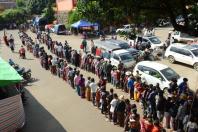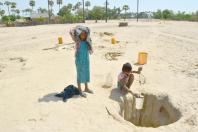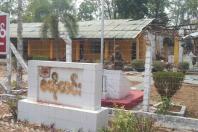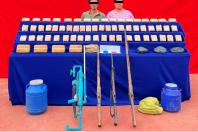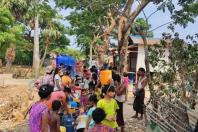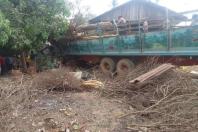On December 8th 1941 the Japanese attacked Malaya. Adm Phillips aboard the battleship HMS Prince of Wales, escorted by the battle cruiser HMS Repulse and the destroyers Electra, Express, Vampire and Tenedos but without air cover, confronted the Japanese fleet. The Prince of Wales and the Repulse were sunk and Adm Phillips killed by Japanese bombers operating from Indo China, revealing the vast disparity between the Royal Navy and Japanese Imperial Navy.
Japanese carrier borne aircraft attacked Ceylon on 5th April 1942, but the resistance they met deterred the Japanese from attempting an invasion of the island. The losses suffered by the Japanese resulted in three of their carriers returning to Japan.
Besides its duties and responsibilities arising from the defence of Ceylon, the Ceylon Defence Force (CDF) was also expected to garrison the small Indian Ocean islands of Diego Garcia, Addu Atoll in the Maldives, Cocos Islands and the Seychelles, and a contingent of the Ceylon Light Infantry (CLI), the Ceylon Garrison Artillery (CGA) and the Ceylon Volunteer Medical Corp, around 75 troops in all under Capt George Gardiner a Colombo accountant, were deployed to the Cocos Islands.
Soldiers loyal to the British, particularly from the CLI helped to put down the mutiny, and its leaders were captured, tried by court martial and three of them, Gratian Fernando, Gunner Carlo Augustus Gauder and Gunner G. Benny de Silva executed in August 1942; the only Empire soldiers executed by court martial for high treason and mutiny during the war. Gratien Fernando’s last words were "Loyalty to a country under the heel of a white man is disloyalty."
The fall of Singapore followed by the Japanese attack on Ceylon had created the prospect of independence with Japanese support for the European colonies in the Indian Ocean, and the mutiny could have been inspired by the young Trotskyists of the Lanka Sama Samaja Party, who alone were opposed to the war. Their party was proscribed, its key leaders imprisoned and some of their activists operated clandestinely in Ceylon and India, creating an anti-British political climate during the War.
At the height of World War II South East Asia Command (SEAC) was established in August 1943 with Admiral Lord Louis Mountbatten KG GCB OM GCSI GCIE GCVO DSO PC FRS as Commander, and the US Gen Joseph Stilwell as Deputy Commander. In April 1944 SEAC moved its headquarters to the Royal Botanical Gardens Peradeniya. Earlier in November 1943 the CDF became part of the British 11th Army Group, which was the land force of SEAC. SEAC staff totalled almost 10,000, and the Command provided employment for over 80,000 civilians in Ceylon both in their construction and then on the bases themselves.
Although the threat of a Japanese attack had long since receded, as late as 1944 the RAF retained three Hurricane night fighter squadrons, two Beaufort torpedo bomber squadrons, a Liberator long range reconnaissance squadron and three Catalina squadrons. Later that year another four squadrons of bombers and four squadrons of fighters, including Spitfires arrived.
The RAF could now focus on new tasks including reconnaissance and mine laying; the Consolidated B-24 Liberators at Minneriya specialised in aerial-mining. By the end of the War India and Ceylon between them had 3,000 aircraft operating under SEAC and US Command, even supplying China, and conducted bombing missions over Burma and Malaya.
The Special Operations Executive (SOE) resulted from bringing together the UK’s three secret services for the duration of the War in order to conduct espionage, sabotage and reconnaissance. Ceylon was initially a base for SOE personnel operating in South East Asia with headquarters in Kandy and a training facility at the Mount Lavinia Hotel. Operatives were inserted into Japanese occupied South East Asia via submarine. When SEAC moved from Delhi to Kandy so did SOE Force 136 under Head of Mission Colin Mackenzie CMG. According to Ashley Jackson, writing in The British Empire and the Second World War, "Ceylon had been transformed strategically from a relative backwater, a mere operations sub-branch of the India Mission, into Force 136's main base."
Capt Freddie Chapman had trained Australian and New Zealand troops in guerrilla warfare at the Special Training School 101 in Singapore. They would remain in Malaya during Japanese occupation to harass the enemy as part of Force 136. Capt Chapman had already forged an alliance with the Malayan Communist Party (MCP) composed of anti-Japanese Chinese. They were armed by the British and instructed to take to the jungles in order to continue the war against the Japanese. The MCP led by the legendry Chin Peng was highly disciplined and were fed, supported and given shelter by local Chinese.
In early 1945 Capt Chapman was brought out to Kandy to arrange for weapons and equipment for his guerrilla fighters about half being Britons who had worked or lived in Malaya before the war, the rest Chinese. "Air supplies from Ceylon supported the 3,500 Malayans trained to harass the Japanese when the British mounted their amphibious assault late in the war. Liberators of No. 357 Squadron from Minneriya in Ceylon, for example, flew 249 sorties in June and July 1945 in support of forces in Malaya," explains Prof Jackson.
In late 1944 Gen Roger Blaizot commander of the Forces Francaises Extrême Orient (the Far East French Expeditionary Forces) arrived in Ceylon along with French troops to establish a Free French Military Mission to the Far East. Gen Blaizot and his troops were inserted into French Indochina where they operated till the end of the War. According to Jackson "Ceylon also became an important (signals) intelligence-gathering outpost of Bletchley Park (the future Government Communications Headquarters [GCHQ]) and a regional headquarters for Special Operations Executive."
In Operation Bunkum launched from Ceylon, agents were ferried by submarine to the Andaman Islands to report back on Japanese forces, a clandestine mission which they carried out successfully maintaining radio contact with Calcutta. In another operation, a group of Thais living in the UK volunteered for a mission for which they boarded the submarine HMS Tactician to be dropped off on the Thai coast. Britain’s Secret Intelligence Service (MI6) also trained Thai agents at SEAC who were ferried by HMS Tactician to carry out assaults in Phuket and Penang.
In collaboration with the Dutch and operating out of bases in Ceylon, RAF Liberators parachuted agents into Sumatra. And the US Office of Strategic Services (the predecessor of the Central Intelligence Agency) also operated out of Ceylon with headquarters in Kandy, training camps in Galle and Trincomalee and a supply depot in Colombo. "RAF Special Duties squadrons, usually flying long-range Liberators, were used to parachute agents and supplies into occupied territory, and most sorties were flown from Ceylon bases," writes Jackson.
While combat experience in Ceylon was limited, the CDF benefited from training with British and Allied units rotated through Sri Lanka, especially for jungle warfare in South East Asia. Individual officers and soldiers of the CDF also had combat experience in other theatres.
In addition to service in the Cocos Islands, members of the CDF also volunteered for active duty in Burma. Writing in his Sunday Times article Forgotten campaign, forgotten veterans Sergei De Silva Ranasinghe says Brian Kirkenbeek was commissioned 2nd Lieutenant with the 2nd Battalion CLI in 1942. In January 1944 he was posted to D Company 4/5th Gurkha Rifles at Arakan where he saw action. On his return to Ceylon he was promoted and rejoined the CLI at China Bay. Ranasinghe goes on to say that some volunteered for service in Europe and experienced combat in that theatre.
Three new units of the CDF were raised during the War, the Ceylon Signal Corp and the Auxiliary Territorial Service in 1943, and the Royal Military Police (Ceylon) in 1944. At the end of the war the CDF which comprised 645 officers and 14,247 other ranks was demobilised. Col R.J.F. Mendis OBE ED was appointed Commander of the CDF in April 1946 and Lt Col Anton M. Muttukumaru became commander of the CLI which reverted to its peacetime strength.
The British noted that the Ceylonese Board of Ministers did everything within their power to maximize the island’s contribution to the war effort. They channelled personnel and material resources in support of the war effort. The only exception being the Lanka Sama Samaja Party which opposed the War and whose leaders were incarcerated or went underground for the duration of the War. However the civilian ministers wholeheartedly supported the war effort and there was total cooperation from the Island’s political, civil and military leadership. In 1948 this political relationship resulted in Ceylon acquiring Dominion Status within months of India. Prof Ashley Jackson in The British Empire and the Second World War concludes that "this was a result of pressure from senior British military and civilian officials in Ceylon in favour of a significant advance towards full self-government."


